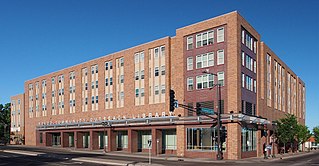
The Minnesota State Capitol is the seat of government for the U.S. state of Minnesota, in its capital city of Saint Paul. It houses the Minnesota Senate, Minnesota House of Representatives, the office of the Attorney General and the office of the Governor. The building also includes a chamber for the Minnesota Supreme Court, although court activities usually take place in the neighboring Minnesota Judicial Center.

The Minnesota Historical Society (MNHS) is a nonprofit educational and cultural institution dedicated to preserving the history of the U.S. state of Minnesota. It was founded by the territorial legislature in 1849, almost a decade before statehood. The Society is named in the Minnesota Constitution. It is headquartered in the Minnesota History Center in downtown Saint Paul.

Near North is a community in Minneapolis northwest of the city's downtown area that contains six smaller neighborhoods. The communities of Near North and Camden are often referred to colloquially as "North Minneapolis". In the early 1900s, the Near North area featured the population center of Jewish people in the city, and since the early 1900s it has been the location of a sizeable African American population and a cultural hub of Black residential and economic development.

Hans Mattson was a Swedish American politician. He served with distinction as a colonel in the American Civil War (1861–65) and in 1869 became the Minnesota Secretary of State. He later served as United States Consul General in India.
MinnPost is a nonprofit online newspaper in Minneapolis, founded in 2007, with a focus on Minnesota news.
HistoryLink is an online encyclopedia of Washington state history. The site has more than 8,100 entries and attracts 5,000 daily visitors. It has 500 biographies and more than 14,000 images.
The IT History Society (ITHS) is an organization that supports the history and scholarship of information technology by encouraging, fostering, and facilitating archival and historical research. Formerly known as the Charles Babbage Foundation, it advises historians, promotes collaboration among academic organizations and museums, and assists IT corporations in preparing and archiving their histories for future studies.

The Encyclopedia of Chicago is a historical reference work covering Chicago and the entire Chicago metropolitan area published by the University of Chicago Press. Released in October 2004, the work is the result of a ten-year collaboration between the Newberry Library and the Chicago Historical Society. It exists in both a hardcover print edition and an online format, known as the Electronic Encyclopedia of Chicago. The print edition is 1117 pages and includes 1400 entries, 2000 biographical sketches, 250 significant business enterprise descriptions, and hundreds of maps. Initially, the internet edition included 1766 entries, 1000 more images and sources.

The Fergus Falls Regional Treatment Center is a former hospital located in Fergus Falls, Minnesota. It was built in the Kirkbride Plan style and first opened to patients in 1890. Over the next century it operated as one of the state's main hospitals for the mentally ill and also worked with people with developmental disabilities and chemical dependency issues. It was added to the National Register of Historic Places in 1986.

The Banfill Tavern, also known as the Locke House, is a historic building in Fridley, Minnesota, United States. It was built in 1847 on the east bank of the Mississippi River and has served variously as an inn, a logging camp office, a private home, a dairy farm, a post office, and a summer home. It is now owned by Anoka County and, until April 2022, housed the non-profit Banfill-Locke Center for the Arts. The building stands within Manomin County Park, and the art center is a partner site of the Mississippi National River and Recreation Area.
Tennessee Encyclopedia is a reference book on the U.S. state of Tennessee that was published in book form in 1998 and has also been available online since 2002. Contents include history, geography, culture, and biography.

The Bemidji Carnegie Library is a former library building in Bemidji, Minnesota, United States. It was built as a Carnegie library in 1909 and housed the city's public library until 1961. It was listed on the National Register of Historic Places in 1980 for its local significance in the themes of architecture and education. It was nominated for being a well-preserved example of a Carnegie library and of public Neoclassical architecture.

Clara Hampson Ueland was an American community activist and suffragist. She was the first president of the Minnesota League of Women Voters and worked to advance public welfare legislation.

The Appeal was a weekly newspaper published from 1885 to 1923. It was one of the most successful African American newspapers of the late nineteenth and early twentieth centuries. Founded in St. Paul, Minnesota, it was published in six separate editions in cities across the United States at the height of its popularity. In 1889 the newspaper changed its name to The Appeal to reflect its expanded geographic scope.

The Duluth Armory is a former armory and event venue in the East Hillside neighborhood of Duluth, Minnesota, United States. It was built in 1915 for the National Guard and naval militia, and expanded in 1941. From the beginning the National Guard also rented out the drill hall as an event venue, as it provided a larger and more flexible space than any other local venue until the construction of the Duluth Arena-Auditorium in 1966.

The Rondo neighborhood, or simply Rondo, is located within the officially designated Summit-University district in Saint Paul, Minnesota. The boundaries of the historically black neighborhood are sometimes referred to as Old Rondo. For much of the 20th century, Rondo was the an important cultural and residential center of the black community in the Minneapolis–Saint Paul metropolitan region. The core of Old Rondo was demolished between 1956 and 1968, to make way for the construction of the Interstate 94 freeway. At least 650 families were displaced from the neighborhood, as well as many businesses and community locations. The neighborhood, although scarred by highway construction, remained a notable area in Saint Paul with a strong sense of cultural identity. Popular media and historians have the explored the impacts of highway construction and gentrification on Rondo residents past and present. In the 2000s, residents and public officials have discussed ways to reconnect the former community.
Many of the newspapers founded in the area that is now the state of Minnesota became Defunct newspapers of Minnesota when they ceased to be published for a variety of reasons. The earliest known newspaper, The Minnesota Weekly Democrat, was founded while the area was part of the Louisiana Purchase in 1803. According to records of the Library of Congress, there have been throughout its history almost 4,000 newspaper titles in the current area of the state of Minnesota, which was founded in 1858. These include newspapers in English, German, Swedish, Russian and other languages, as well as Native American newspapers. There were approximately 500 newspapers in Minnesota at the beginning of 2020.












